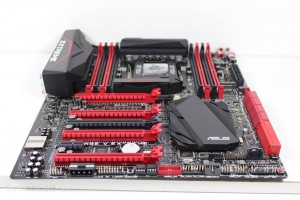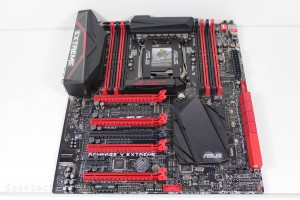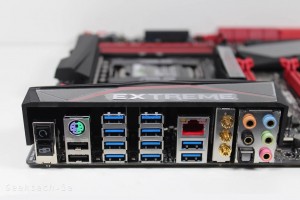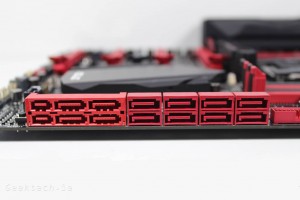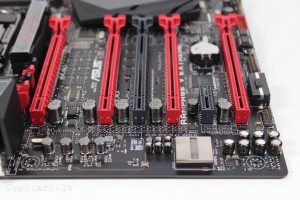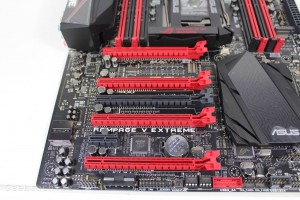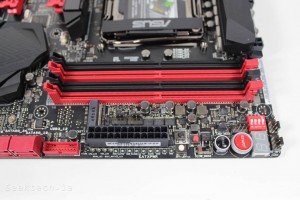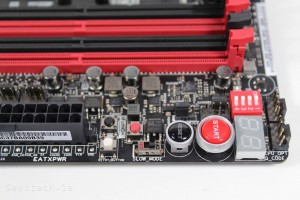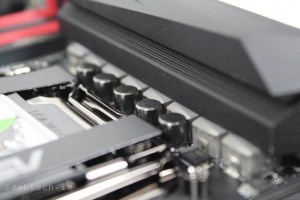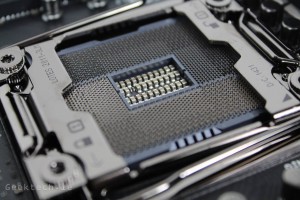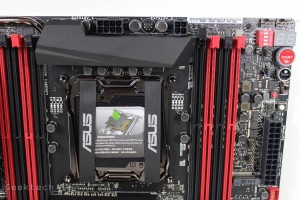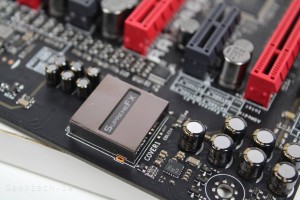The Rampage V Extreme
The Rampage V Extreme continues the long tradition of Black and Red design. It has been done a lot in recent years, but with the Rampage V Extreme if feels like home. These are the only shots that cover the entire board, and quick things to note is that the board has a total 8 PWM fan headers and the BIOS includes complete control over all of them. You can even connect up splitters to any of the headers and run specific fans of the same header with the same fan curve.
The back I/O includes a clear CMOS buttons, USB flashback button/ROG connect. 1 x ps/2 connection. 2 x USB 2.0 ports with Keybot support. An insane 10 x USB 3.0 ports. 1 x Gigabit Intel 1218V Ethernet, 3×3 WiFi AC aerial connections (supports up to 1,300Mbps speed). Lastly we have 6 x 3.5mm jacks for 8 channel audio and 1 x optical/Spdif.
Asus include a total of 12 SATA 6 Gbps ports with 4 of them tied into the 2 SATA express connectors. So you either have 8 x SATA 6Gbps and 2 SATA Express or just 12 x SATA 6Gbps. 1 of the SATA express ports uses an ASMedia controller with the other done by Intel.
Here we have some fun with 4 x PCIe 3.0 slots, 1 x PCIe 2.0 slot and 1 x PCIe 2.0 X1 slot. The PCIe 3.0 supports 1 card @x16, 2 cards @ x16/x16, 3 cards @ x16/x8/x8, or 4 cards @ x16/x8/x8/x8 with a 40 lane CPU (5960x, 5930k) or 1 card @ x16, 2 cards @ x16/x8, 3 cards @ x8/x8/x8 with a 28 lane CPU (5820k). A 5820k will permanently diable the bottom PCIe 3.0 slot and leave the M.2 SATA enabled. Using a 5930k or 5960x i.e a 40 lane CPU will leave both enabled, but if both are used, the bottom PCIe 3.0 slot will run at x4 or it can run at X8 withouth the M.2 Slot being occupied.
Here we have the OC Zone. It features a few handy and much needed overclocking features. Starting with the now standard on board Reset/Power buttons. Asus are now including both a Safe boot and Retry button. The safe boot will boot to the last known safe bios settings and go straight to the BIOS, but will retain your previous settings that failed. It just simply gets you to the bios for more tweaking. The retry button as you probably guessed it simply reboots the system with the same settings, handy if your overclock failed to post and you want to try again.
Other things we have seen before are the PCIe 3.0 switches for shutting off specfic lanes on the board. We also have the 2-digit Q-core for posting codes. There is also the line of probeit points for checking volts. We also have a MemOK! button which quickly checks RAM compatibility.. Lastly we have the slow mode switch, which is aimed at massive overclocks with LN2 – where slowing down the frequency to sync up temperatures when using LN2.
On the left we can see the new DirectCU heatsink ontop of the VRM’s. Asus want to make sure these things got decent cooling on them and took some pointers from their graphics cards. A copper pipe has direct contact with the top of the VRM’s and extends to the heatsink above the back I/O. This should help dissipate some of the intense heat the VRMS will be putting out. Asus’s are using the Extreme Engine Digi+ IV, which is exclusive to the Rampage V Extreme. It features MicroFine alloy chokes with the VRM’s using a PowIRstage Ir3555 chip. It integrates the driver, high-side and low-side MOSEFETS and features the latest RDS current-sensing technology. Basically, everything runs cooler, has a higher efficiency and as such a longer lifespan.
Asus’s OC Socket is rather unqie. Instead of going with the reference 2011v3 socket that Intel released. Asus reversed engineered the same 2011v3 socket that was used at testing stages. This socket includes more pins compared to the standard Intel socket – which are said to allow for better overclocking, or at least more stable overclocking as it allows for a more a more extreme Vcore without any drop in voltage. This is probably only going to help those going for mad benchmarks with LN2 and putting serious volts into their CPU’s. It may benefit those overclocking a little, but Asus’s own info on the socket shows volts at 1.8, which are way above normal overclocking and reservered for LN2 teritory. That may just be an exaggerated example, but ultimately the extra pins are there for serious overclocking.
Here we can see above the socket and the VRM heatsink from above. The included 8 and 4 pin power are available for whichever one you need. The included SupremeFX 2014 sound is the first time we are seeing decent audio included in a Rampage Extreme board. It includes an isolated sound PCB for little to no interference. The separation is also covered in a few RED LED’s, just to make things look a little better.
Other features for the integrated sound card are stainless steel nickel EMI shielding and ELNA capacitors. They do include a sound stage button for quickly switching profiles, but being on the motherboard itself means those that would want to use probably can’t, with it being inside their case and all. Ultimately it’s really good to see decent audio out of the box and Asus also include a built in pre-amp for headphones. This actually goes hand in hand with the ROG branding and gamers will be pleased.
2. Photos and Features
